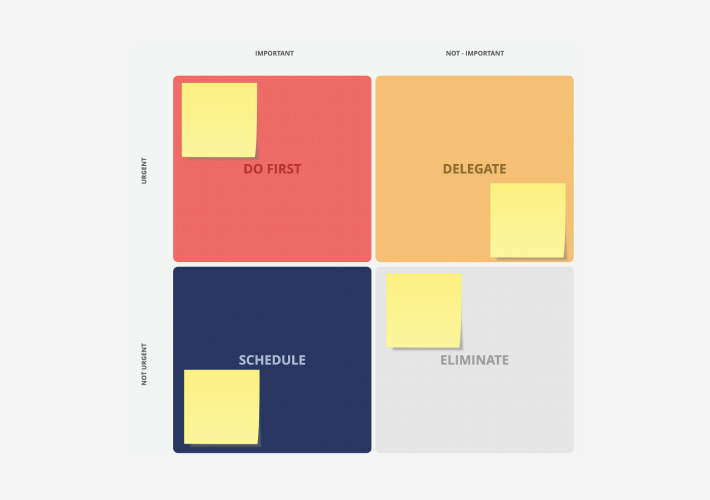Eisenhower matrix template
The Eisenhower matrix, or the urgent-important matrix, is a productivity tool used to prioritize tasks based on urgency and importance.
Use this template
What is an Eisenhower matrix template?
The Eisenhower matrix template is a decision-making tool that helps people prioritize tasks based on its urgency and importance. Individuals can visualize their tasks and make better-informed decisions about where to allocate their time and energy.
The matrix consists of four quadrants:
- Important and urgent (Do first): Tasks in this quadrant are both important and require immediate attention. Examples are tasks with deadlines, crises, and emergencies that need to be addressed immediately.
- Important but not urgent (Schedule): Tasks in this quadrant are important for long-term goals or strategic objectives, but aren't urgent. Examples include planning, goal setting, skill development, and relationship building.
- Urgent but not important (Delegate): Tasks in this quadrant are urgent but don't contribute to long-term goals. Examples include some phone calls, emails, meetings, or minor tasks. These tasks should be minimized whenever possible, to free up time for more important activities.
- Not urgent and not important (Eliminate): Tasks in this quadrant are neither urgent nor important, providing little or no value. These tasks should be eliminated or minimized, so you can focus on activities that contribute to any overall goals and priorities.
Who is this template for?
The Eisenhower matrix template can be used by individuals to better manage their time and prioritize tasks. It can also be used by team leaders, managers, organizations, and teams to prioritize tasks and allocate resources effectively.
Some of the common usages of the Eisenhower matrix template are:
- Task prioritization: To determine which tasks should be tackled first
- Time management: To prevent wasting time on low-value and non-urgent tasks
- Project management: To pick essential tasks and avoid getting derailed by low-priority tasks
- Team collaboration: To prioritize tasks and allocate resources effectively
- Stress reduction: To minimize feeling overwhelmed, by following a structured approach to task management
How to use this template
- To use the Eisenhower matrix, simply list your tasks in the appropriate quadrant based on their urgency and importance.
- Tasks that are both urgent and important should be done first and given high priority. The tasks that are important but not urgent should be scheduled for a later time or date.
- Tasks that are urgent but not important should be delegated to someone else if possible, and tasks that are neither urgent nor important should be eliminated from your to-do list altogether.
